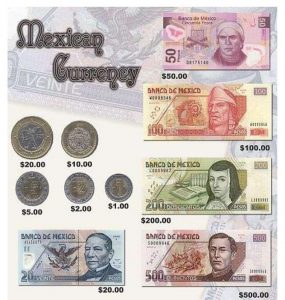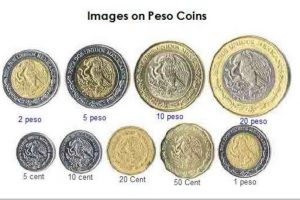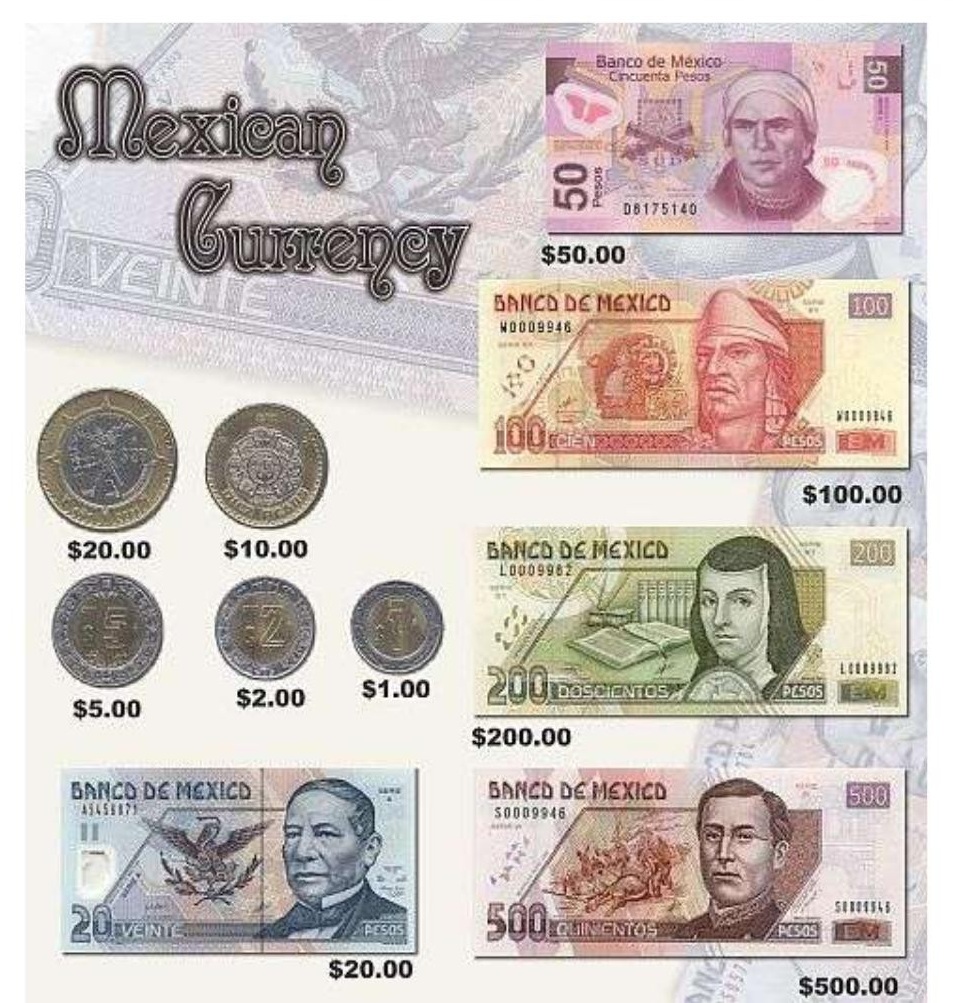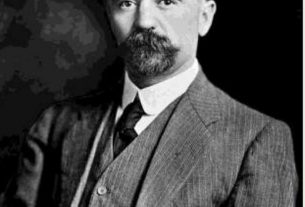By Terry Sovil from the October 2011 Edition
You probably recognize that in Mexico CHANGE (in rules) is inevitable but CHANGE for a $200 Peso note may be impossible.
 Grab bills, coins and a By Terry Sovil magnifying glass.You will get a little insight and learn more about what you have in your pocket!
Grab bills, coins and a By Terry Sovil magnifying glass.You will get a little insight and learn more about what you have in your pocket!
The original Mexican peso coins were the first to use exact weights along with a very intricate border to prevent counterfeiting. They were also made of pure silver! Pesos use the symbol, “$”, the same as US dollars, which was originally taken from Spanish-Mexican currency. They are denoted as US dollars “USD $”, and Mexican pesos, “MXN $”.
Coins
The peso can be broken into 5¢, 10¢, 20¢ and 50¢ centavos. The 5¢ and 10¢ coins are made of steel and the 20¢ and 50¢ coins are bronze. The rings on the obverse side (the side bearing the head or principal design) are taken from an Aztec Sun Stone. This artifact contains a design of how the Aztec measured time. You can see it in Mexico City’s Chapultepec Park.
Common peso coins are the $1, $2, $5, $10 and $20. The $20, $50 and $100 peso coins are rare! The $1, $2 and $5 coins have bronze centers with steel rings. The MXN $10 and $20 coins have steel centers with bronze rings. The rings on the reverse side are also taken from the Aztec Sun Stone. The Mexican Coat of Arms is repeated on the obverse; it is very similar to Aztec symbols created 700 hundred years ago. It shows a Mexican Golden Eagle on a cactus devouring a snake. It came to symbolize the triumph of good over evil.
The $10 peso coin shows the Tonatiuh (the Sun God) contained in the center of the Aztec Sun Stone. The $20 peso coin shows Miguel Hidalgo, the Father of Mexican Independence. The $1, $2 and $5 peso coin show various rings similar to the centavos. The $1 coin shows a Sunshine Ring, the $ 2 coin shows a Days Ring Detail and the $5 coin shows a snakes ring.
Most Common Bank Notes
The front side of most bank notes, in the upper right corner, will display the denomination value. There may also be a set of hieroglyphics to the left or even in the lower right corner of the note. These are used by sight-impaired individuals to determine the denomination of the note.
The Mexican $20 Front shows Benito Juarez , arguably
Mexico’s most popular president. The back shows a statue of Juarez along with the Angel of Independence and the Lady of Justice.
The Mexican $50 Front shows José María Morelos, who took leadership of the Mexican Independence movement after the death of Miguel Hidalgo. The back shows the Aqueduct in Morelia, Michoacan.
The Mexican $100 Front shows Nezahualcoyotl (Nets-ah-wahl-coy’-ohtl, Coyote who Fasts) on the front. Nezahualcoyotl was the ruler of Texcoco and honored as a sage and poet-king. He was the patron to the tlamatini (wise men) of philosophers, muscians, scupltors and artists. His rule ushered in a Texcoco Golden Age of scholarship, engineering and the arts. He created public works (a massive aqueduct and water treatment system) and instigated judicial reform by creating councils of finance, war, music (culture) and justice.
Remembered as a poet, if you look very closely, a magnifying glass will help, you will find a tiny poem printed on the face of the 100 Peso note to the upper left of his image. It begins with: Amo el canto de zenzontle…. and is translated as:
 “I love the song of the mockingbird Bird of four hundred voices, I love the color of the jadestone And the enervating perfume of flowers, But more than all I love my brother: man. “
“I love the song of the mockingbird Bird of four hundred voices, I love the color of the jadestone And the enervating perfume of flowers, But more than all I love my brother: man. “
The back of the note shows a Xochipilli (flower prince) statue. The statue was unearthed in the mid-1800s on the side of the volcano Popocatépetl near Tlamanalco. Thestatue is currently located in the National Museum of Anthropology in Mexico City’s Chapultepec Park.
The Mexican $200 Front shows Sister Juana de Asbaje. She was a self-educated peasant with mastery as a writer of all genres (sacred documents, essay and poetry). She composed plays and poems that questioned the role of women in society and male hypocrisy. She was critical of the Catholic Church and they eventually forced her to stop writing. With your magnifying glass you can read the poem in the open book! The back of the note shows the Temple of San Jerónimo founded by the Dominican Friar Jordon de Santa Catalina during the 16th century. He spent 25 years there without ever going out writing the first Zapotec language dictionary.
The Mexican $500 Front shows Ignazio Zaragoza, a Mexican General, Minister of War and national hero. Zaragoza won a victory against the French at the Battle of Puebla which is today celebrated as Cinco de Mayo. He wrote a one-line letter to Benito Juárez: “Las armas nacionales se han cubierto de gloria (The national arms have been covered with glory)” which can be seen to the lower right of his image. The back shows the Cathedral of Puebla.
Manzanillo Sun eZine References:
Check the back issues
Miguel Hidalgo-20 peso coin -June 2010 Issue
Benito Juarez-MXN 20 peso note –July 2010 Issue
José María Morelos-MXN 50 peso note – Nov 2010 Issue
Sister Juana de Asbaje-MXN 200 peso note – Aug 2010 Issue
Ignazio Zaragoza-MXN 500 peso note – Sept2011 Issue
Download the full edition or view it online
—
Terry is a founding partner and scuba instructor for Aquatic Sports and Adventures (Deportes y Aventuras Acuáticas) in Manzanillo. A PADI (Professional Association of Dive Instructors) Master Instructor in his 36th year as a PADI Professional. He also holds 15 Specialty Instructor Course ratings. Terry held a US Coast Guard 50-Ton Masters (Captain’s) License. In his past corporate life, he worked in computers from 1973 to 2005 from a computer operator to a project manager for companies including GE Capital Fleet Services and Target. From 2005 to 2008, he developed and oversaw delivery of training to Target’s Loss Prevention (Asset Protection) employees on the West Coast, USA. He led a network of 80+ instructors, evaluated training, performed needs assessments and gathered feedback on the delivery of training, conducted training in Crisis Leadership and Non-Violent Crisis Intervention to Target executives. Independently, he has taught hundreds of hours of skills-based training in American Red Cross CPR, First Aid, SCUBA and sailing and managed a staff of Project Managers at LogicBay in the production of multi-media training and web sites in a fast-paced environment of artists, instructional designers, writers and developers, creating a variety of interactive training and support products for Fortune 1000 companies.





You must be logged in to post a comment.